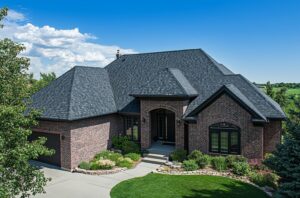Choosing the right roofing material is one of the most important decisions a homeowner can make. Whether you’re planning a new roof or replacing an old one, architectural shingles are one of the most popular and effective choices available today. But what makes them different from other shingles? And are they the right fit for Texas homes?
This guide to architectural shingles will walk you through everything you need to know—from their structure and durability to cost, style options, and how they compare to standard 3-tab shingles. You’ll also learn how they perform in Texas weather and why more homeowners are turning to them for long-term value and curb appeal.
What Are Architectural Shingles?
Architectural shingles, also known as dimensional or laminated shingles, are a high-performance upgrade over traditional 3-tab asphalt shingles. They are composed of multiple layers of asphalt fused together, giving them a thicker, more dimensional appearance and enhanced durability.
Unlike flat 3-tab shingles, architectural shingles are designed to mimic the look of natural slate or wood shake—making them both functional and visually appealing.
Key Features of Architectural Shingles
Here’s what sets architectural shingles apart from other roofing materials:
- Multi-layer construction for superior strength
- Varied shading and texture for added depth and aesthetic appeal
- Heavier weight than 3-tab shingles, offering greater wind resistance
- Longer warranties (often 30 years or more)
Architectural shingles strike a balance between affordability, durability, and design versatility, making them a smart choice for a wide range of homes.
How Long Do Architectural Shingles Last?
One of the top reasons homeowners choose architectural shingles is longevity. On average, you can expect these shingles to last 25 to 30 years, with many premium options offering lifespans of up to 40 years or more when properly installed and maintained.
Factors that influence lifespan include:
- Roof ventilation and attic insulation
- Local climate conditions
- Installation quality
- Regular roof maintenance
For homes in Texas, where intense sun, high winds, and occasional hail are common, architectural shingles provide more resilience than entry-level roofing materials.
Benefits of Architectural Shingles in Texas
Texas homeowners need roofing that can stand up to extreme heat, rapid temperature changes, and severe weather events. Architectural shingles are well-suited for these challenges.
1. Wind and Impact Resistance
Most architectural shingles are rated to withstand winds up to 110–130 mph. That’s critical in regions prone to storms and hurricanes.
2. UV Protection
Texas sunlight is intense. The multiple layers in architectural shingles provide better UV protection, reducing the risk of cracking, curling, and premature aging.
3. Insulation and Energy Savings
Thicker shingles offer better insulation, which helps reduce heat transfer. Combined with proper attic ventilation, they can help lower your cooling costs during Texas summers.
4. Aesthetic Value
Available in a wide variety of colors, styles, and textures, architectural shingles add depth and character to your home’s roofline—boosting curb appeal and resale value.
Architectural Shingles vs. 3-Tab Shingles
It’s important to understand how architectural shingles compare to the standard 3-tab variety.
| Feature | 3-Tab Shingles | Architectural Shingles |
| Lifespan | 15–20 years | 25–40 years |
| Wind Resistance | Up to 60 mph | Up to 130 mph |
| Appearance | Flat, uniform | Textured, dimensional |
| Weight | Lightweight | Heavier and more durable |
| Cost | Lower upfront | Higher initial, better value |
While 3-tab shingles may save you money upfront, architectural shingles typically offer better long-term ROI due to fewer repairs, longer life, and improved energy efficiency.
How Much Do Architectural Shingles Cost?
The cost to install architectural shingles in Texas typically ranges between $4.50 to $7.50 per square foot, including materials and labor. The total price will vary based on:
- Roof size and pitch
- Underlayment and flashing needs
- Removal of old roofing
- Type and brand of shingles
Many manufacturers offer extended warranties (30 years, 50 years, or even limited lifetime) on architectural shingles, giving homeowners additional peace of mind.

Popular Styles of Architectural Shingles
Architectural shingles come in several design variations to suit different home styles and preferences:
🏠 High-Definition Shingles
These feature enhanced shadow lines and color blending for a bold, textured appearance.
🧱 Slate-Style Shingles
Made to resemble natural slate, these offer a classic, high-end look without the weight and cost of real stone.
🌲 Shake-Style Shingles
Designed to mimic the rugged beauty of hand-split cedar shakes, perfect for Craftsman or rustic homes.
Each style is engineered for performance as well as beauty, providing homeowners with both strength and elegance.
Roof Installation: Why Quality Matters
Even the best shingles won’t perform if they’re installed incorrectly. At Compass Roofing TX, we make sure every architectural shingle installation is handled with precision and care.
Our installation process includes:
- Thorough roof inspection
- Removal of old roofing and evaluation of the decking
- Installation of water-resistant underlayment
- Proper nailing techniques and flashing
- Final inspection and cleanup
A poorly installed roof can void warranties and reduce the life of your shingles. That’s why working with a trusted, experienced local contractor is essential.
Are Architectural Shingles Eco-Friendly?
Architectural shingles may not be fully recyclable like metal roofing, but many manufacturers are working to reduce their environmental footprint. Shingles are often made with:
- Fiberglass mats that provide strength and fire resistance
- Asphalt sourced with improved refining practices
- Granules that reflect heat and reduce energy consumption
According to the EPA’s sustainable materials management guidelines, improving material reuse and recycling in roofing is a growing priority nationwide.
Homeowners can also choose cool-roof rated shingles that reflect more sunlight, keeping homes cooler and reducing HVAC load.
Caring for Your Architectural Shingles
Maintenance plays a major role in how long your shingles will last. Here are a few best practices to follow:
- Clean your gutters regularly to prevent water backup
- Inspect your roof annually or after major storms
- Remove debris like leaves and branches that can trap moisture
- Address repairs promptly to avoid widespread damage
- Ensure proper attic ventilation to reduce heat buildup
Regular roof maintenance can extend the lifespan of your shingles by several years.
Should You Upgrade to Architectural Shingles?
If you’re still using 3-tab shingles or your roof is over 15 years old, now may be the perfect time to upgrade to architectural shingles.
Reasons to consider the switch:
- You want a longer-lasting roofing system
- Your home is in a storm-prone area like Texas
- You’re planning to sell your home and want better curb appeal
- Your current shingles are showing signs of age or damage
Investing in architectural shingles now can save you from costly repairs later—and improve your home’s comfort, protection, and value in the process.
Let’s Talk About Your Roof
At Compass Roofing TX, we’ve installed hundreds of architectural shingle systems across the state. Our team is trained to help you choose the best product for your budget, climate, and style preferences.
Whether your current roof is aging or you’re building new, we’re here to guide you every step of the way—from inspection and estimate to final installation.
Get a free inspection now and find out if architectural shingles are the best fit for your home. There’s no obligation, just expert advice and total peace of mind.



